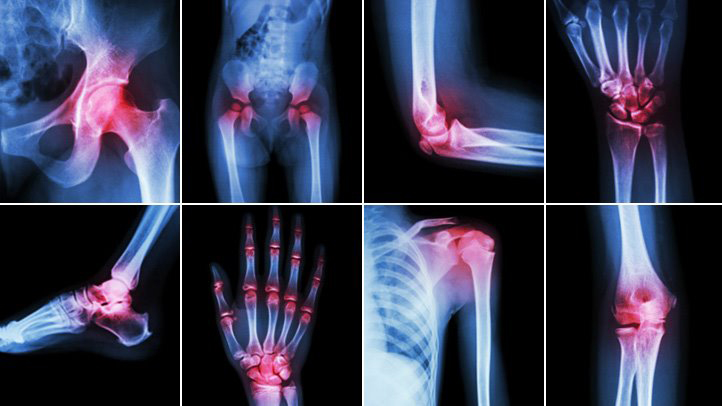
Arthritis is a general term for a group of painful conditions that involve inflammation and stiffness of the joints. The different types of arthritis can occur in any joint in the body, including the hands, shoulders, knees, hips and ankles. As a degenerative condition, it’s the primary cause of disability in the U.S., and more than 50 million adults are affected. The condition develops more often at older ages and in women, but people of any age and gender are susceptible to it. In fact, the U.S. currently has about 300,000 cases of children with some form of the disease.
Arthritis occurs for many reasons, depending on the type. Understanding the causes for the different types may not help you avoid developing it, but it can help you recognize the early signs of the disease. Early treatment gives you an edge in fighting the joint degeneration that goes with every form of arthritis.
What Are the Types of Arthritis?
As a broad classification for diseases that affect the joints, arthritis can be broken down into four different types: degenerative, inflammatory, infectious and metabolic. Degenerative arthritis consists of osteoarthritis, the most common type of arthritis. Inflammatory arthritis includes rheumatoid arthritis, psoriatic arthritis and ankylosing spondylitis. Infectious arthritis occurs when a joint becomes infected. Reactive arthritis and septic arthritis are two forms of infectious arthritis. In metabolic arthritis, uric acid builds up and creates crystals in the joint, causing a painful condition called gout.
The inflammation associated with the different types of arthritis can occur in just one joint or in multiple joints in the same area or even in different parts of the body. The predominant symptoms across all types of arthritis are pain, stiffness and swelling in the affected joints. In some cases, the swollen joints look red and irritated, although the skin itself isn’t affected. Range of movement is also generally limited in the affected joint.
Causes of Osteoarthritis
Osteoarthritis involves the deterioration of the cartilage in joints and typically happens due to normal wear and tear that occurs with aging. When this happens, your bones essentially start grinding against each other instead of being cushioned by the cartilage. This causes pain and also reduces the range of motion for the joint. In most cases, osteoarthritis begins gradually, with the severity increasing with age. However, infections and injuries that affect the joint can cause osteoarthritis to develop at a much earlier age than normal.
Although osteoarthritis often simply goes hand in hand with living a long life, certain risk factors can increase your likelihood of developing osteoarthritis. Besides age and joint injuries, the primary risk factors include being overweight, working at a job or engaging in a hobby with repetitive movements, and having a family history of osteoarthritis.
Causes of Rheumatoid Arthritis
One of several autoimmune diseases, rheumatoid arthritis occurs when your immune system attacks the lining — known as the synovial membrane — surrounding your joints instead of protecting the joints as it should. This causes painful inflammation and stiffness that eventually permanently damages the cartilage and bone as the disease progresses. The exact causes of autoimmune diseases remain a mystery, although most researchers believe that environmental factors trigger autoimmune responses in certain people based on genetics.
That means that factors like family history, gender — women are at greater risk than men — and other characteristics related to your DNA play a role in your risk of developing rheumatoid arthritis. This type of arthritis typically occurs in middle age, although it can occur at any age. Environmental contaminants, such as asbestos, and habits like smoking are treated as toxic exposures by the body and could potentially trigger an autoimmune response that manifests as rheumatoid arthritis. As with osteoarthritis, obesity also increases the risk of developing this type of arthritis.
Diagnosing Arthritis
If you are experiencing pain, inflammation and other symptoms that lead you to believe you could have any form of arthritis, you need to discuss your symptoms with your doctor. Early arthritis symptoms tend to be more painful than dangerous, but an early diagnosis gives you and your doctor a chance to halt or slow down the progression of the disease instead of just working on options to manage the pain.
To complete a diagnosis, your doctor will probably order X-rays, an MRI and an ultrasound to look at your joints and blood tests to look for other indicators of arthritis, such as C-reactive protein (CRP) and erythrocyte sedimentation rate. A joint fluid analysis may be done to rule out gout or an infection in the joint. After a diagnosis is made, you may be referred to a specialist for a focused treatment plan.
Typical Treatment Options for Arthritis
The exact course of treatment depends on the type of arthritis you have and the progression of the disease in your joints. Your doctor will probably recommend an over-the-counter analgesic like acetaminophen or a nonsteroidal anti-inflammatory drugs (NSAIDs) like ibuprofen to help with the pain and inflammation. Prescription medication options include duloxetine for osteoarthritis and disease-modifying antirheumatic drugs (DMARDs) for rheumatoid arthritis.
Physical therapy can also be effective for improving muscle tone and making them stronger, which can also help improve range of motion in some cases. Occupational therapy focuses on helping you learn new ways to do common tasks to put less strain on the affected joints. In more severe cases, these treatments may not help, and you may need steroid injections to relieve pain or even surgery. Surgical options include procedures to realign bones as well as those to completely replace damaged joints.
Resource Links:
https://www.mayoclinic.org/diseases-conditions/arthritis/symptoms-causes/syc-20350772
https://www.arthritis.org/health-wellness/about-arthritis/understanding-arthritis/what-is-arthritis
https://www.mayoclinic.org/diseases-conditions/rheumatoid-arthritis/symptoms-causes/syc-20353648
https://www.mayoclinic.org/diseases-conditions/rheumatoid-arthritis/diagnosis-treatment/drc-20353653
https://www.mayoclinic.org/diseases-conditions/osteoarthritis/symptoms-causes/syc-20351925
https://www.mayoclinic.org/diseases-conditions/osteoarthritis/diagnosis-treatment/drc-20351930





